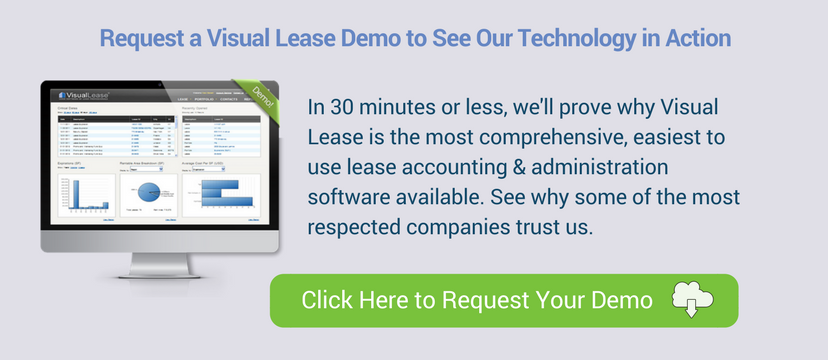 Because of the new FASB and IFRS lease accounting changes, leases are an increasingly visible part of your organization’s financial reporting. Leases are now being carefully scrutinized by everyone, including financial leadership, real estate strategists, procurement teams and external auditors, because the risks associated with poor lease decisions have suddenly been magnified. That’s why, as your organization prepares to comply with the new lease accounting rules, lease portfolio management and oversight are more important than ever before.
Because of the new FASB and IFRS lease accounting changes, leases are an increasingly visible part of your organization’s financial reporting. Leases are now being carefully scrutinized by everyone, including financial leadership, real estate strategists, procurement teams and external auditors, because the risks associated with poor lease decisions have suddenly been magnified. That’s why, as your organization prepares to comply with the new lease accounting rules, lease portfolio management and oversight are more important than ever before.
When we talk about lease portfolio management, in the past that meant real estate. Now property leases are only one component of your company’s lease portfolio management equation. Leases for every conceivable type of asset must be accounted for, which requires standard procedures and controls for managing the leases. While some organizations may have these in place for high-value real estate leases, very few have standard policies and processes for equipment lease portfolio management. And those that do exist are probably not implemented uniformly throughout the organization.
Related article: Equipment and Property Lease Accounting: Can One System Do Both
While your accounting teams are preparing for the lease accounting changes, now is the time to put lease portfolio management policies and procedures into practice across all teams that handle lease portfolio administration.
Policies and procedures organizations will need to implement for lease portfolio management
Centralize lease data
Getting compliant with the FASB & IFRS standards will, for most companies, require you to move all your lease data into a central repository that will feed lease accounting calculations, journal entries and disclosures to your GL.
While you’re figuring out how to get all the lease data you currently have into a new system, make sure you create policies and procedures for adding new leases once you’ve implemented your new software. Especially for equipment leases that were never tracked before, procurement and IT groups that obtain and maintain these items will need to be trained on how to enter new lease data into the lease management & accounting system.
TIP: Training many new people on new technology can be a burden. Your best bet? Choose intuitive software that’s simple to understand and use without extensive training.
Create an audit trail
Property leases in particular can have many changes throughout the course of the lease term. Not only must every change be recorded in your lease management and accounting system, but with just about every global lease being tracked, there are many people involved in making changes. That means you must put policies and procedures into place to track change approvals and submissions. You’ll need these in case of questions or problems with day-to-day lease administration and also in the event of financial audits.
TIP: Make sure your lease accounting software can support your audit trail, with drill-down capabilities that link data to supporting documents and fields to track changes and approvals.
Standardize lease requisition and monitoring
Before the new lease accounting standards were announced, most leases (especially your equipment lease portfolio) were hidden away in file drawers. As a result, companies had little reason to establish consistent processes for lease requisition and approval. Monitoring lease changes probably didn’t happen at all.
Now that you must roll up lease data for inclusion on the balance sheet and in financial reports, having accurate and consistent data is essential and your lease portfolio management practices must be expanded and organized. Every group that’s involved in acquiring and maintaining leases should follow standard practices for lease negotiations, processing new leases, documenting lease changes, and handling lease terminations.
TIP: Because lease changes now significantly impact your financial reporting, make sure your lease accounting software has automated re-measurement tracking.
Create lease vs. buy guidelines
The balance sheet impact of the new lease accounting changes is a concern for many organizations. Your decisions about how best to acquire and finance assets are more important than ever. Especially for large organizations with many departments and people involved in acquiring assets, providing guidance into the decision making process can have a positive impact on the company’s financial picture.
TIP: When you have one system that serves as a central source of truth for ALL lease data, you’ve got an invaluable source of intelligence for lease portfolio analysis that can help you craft those guidelines.
Establish internal controls
Documenting standard operating procedures around lease portfolio management is only half the battle. You must put internal controls in place to monitor compliance with these processes across your organization. With lease accounting on the balance sheet and now subject to Sarbanes-Oxley compliance, there’s no margin for error.
TIP: Your lease management software can actually help you monitor compliance with lease policies. For example, Visual Lease has an audit tool that identifies lease payments that fall outside parameters that you set. This type of tool helps you identify mistakes, and significantly reduce lease expenses in the process.
5 steps to transforming lease portfolio management
Overhauling your processes and procedures related to lease portfolio management may seem like a daunting task, but doing it now will save you big headaches down the road. You’ll also be in the best position to take advantage of your centralized lease accounting data to make better decisions and optimize expense for leased assets.
- Start by assembling a high-level team, including your CFO, Controller, senior accounting managers, as well as heads of corporate real estate and procurement.
- Assemble the resources to understand and analyze how different groups are handling lease portfolio management currently.
- As your organization begins pulling together lease data for FASB and IFRS compliance, the cross-functional leadership team should develop the related policies and procedures that need to be implemented across the organization to support ongoing lease portfolio management.
- Make a transition plan to roll out the changes throughout all affected teams, and get everyone up to speed on the new lease portfolio management policies and processes.
- Choose the right technology to make lease portfolio management easier. In addition to the tips mentioned above, the critical factor for reducing risk, cutting costs and maximizing productivity is having one system to handle ALL your lease portfolio management and accounting tasks.
Are you still looking for the right lease management and accounting technology for your organization? Request a Visual Lease demo today.
























